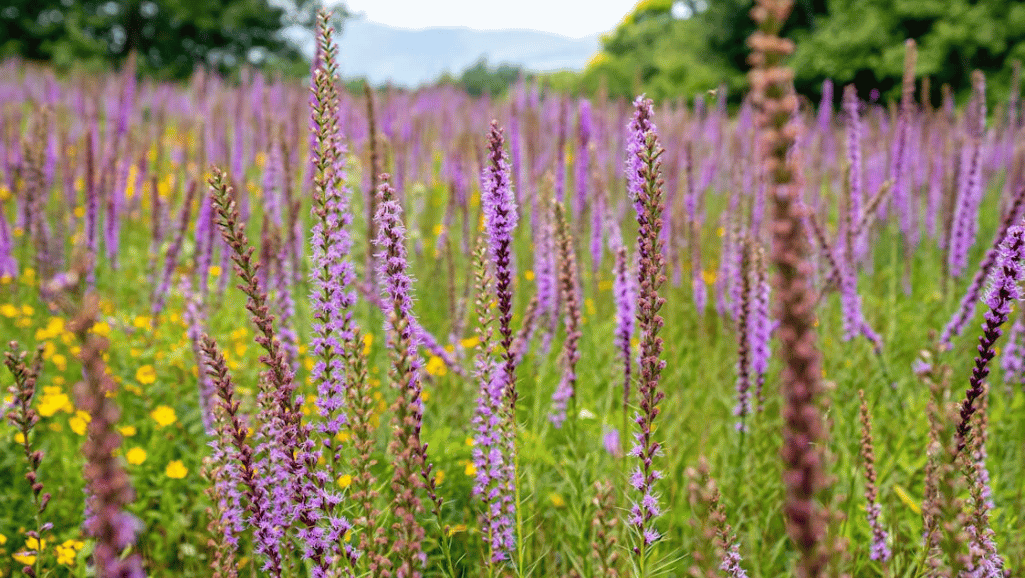
Beautiful flowers gardenia Plants For Your homes

Liatris spicata, also known as dense blazing star or gayfeather, is a standout in gardens. It brings height and color to your landscape. These wildflowers are native to North America and do well in zones 3 through 8.
They’re perfect for most areas in the United States. Liatris spicata loves prairies and open woodlands. This makes it great for many garden styles.
The Liatris genus is mainly from Eastern North America and Canada. It’s an easy-to-grow perennial that doesn’t need much care. Gayfeather, or Liatris, was chosen as the pollinator plant of the year by The Texas Butterfly Ranch. This highlights its role in supporting local ecosystems.
Gayfeather, also known as Liatris, is a beautiful perennial flower loved by gardeners and pollinators. This native variety was chosen as the pollinator plant of the year by The Texas Butterfly Ranch. It’s known for its tall spikes of purple or white flowers that bloom from top to bottom. These flowers add a striking look to any garden.
The native variety, Liatris punctata var. mucronata, is hard to find because its seeds are rare. But, Liatris spicata is easier to find in nurseries. It grows well in average garden soils that are kept moist but also need good drainage.
Gayfeather is loved for attracting pollinators, especially during the fall migration of Monarch butterflies. From late July to October, its purple flowers draw in many pollinators, including:
Gayfeather fits well in many gardens, like meadows, prairies, and cottage gardens. It also works in butterfly gardens, rain gardens, and areas being rewilded or xeriscaped. It pairs well with plants like beardtongue and beebalm, making it a great choice for any garden design.
| Species | Height | Native Range |
|---|---|---|
| Liatris spicata | 3-6 feet | New Jersey to Michigan and Illinois, south to Florida and Louisiana |
| Liatris punctata var. mucronata | Up to 4 feet | Eastern North America |
With about 40 species in the Liatris genus, Gayfeather offers many options for gardeners. It adds texture, color, and attracts pollinators to gardens. Remember its needs for moisture, soil, and companion plants to create a garden that’s great for pollinators.
The Liatris genus has about 32 species, mainly found in eastern North America and Canada, east of the Rocky Mountains. The USDA Plant Guide says these plants are in the U.S., southern Canada, and northern Mexico. Three species are listed or might be listed as endangered.
Liatris spicata is a favorite in gardens and comes from eastern North America. It loves moist prairies and sedge meadows. It’s perfect for the eastern U.S., fitting well in prairie restorations or natural gardens.
This plant grows in hardiness zones 3-8, from the Midwest to the East Coast, and in eastern and western Canada.
Liatris spicata grows from New Jersey to Michigan and Illinois, down to Florida and Louisiana. It’s also found northeastward. This adaptable plant does well in many places, making it great for gardens in the eastern U.S. and Canada.
Liatris species love prairies and open woodlands, with Liatris spicata liking moist, open woodlands, mesic prairies, and marsh edges. These places are perfect for it to grow and bloom. It draws in butterflies, bees, and hummingbirds.
Adding Liatris spicata to prairie restorations or natural gardens brings a beautiful vertical look. Its tall, purple spikes can grow 2 to 5 feet high.
Gardeners love Gayfeather (Liatris) for its ability to grow in many conditions. It’s great for those who want easy-care, water-saving gardens. Its toughness makes it perfect for xeriscaping, a style that saves water by using plants that like dry conditions.
Liatris loves full sun, needing at least six hours of direct sunlight daily. But, it can also handle some shade, especially in hot places to avoid too much heat. In cooler areas, full sun helps it grow big and bloom well.
For Liatris to thrive, the soil must drain well. It grows best in sandy or rocky soils that let water drain fast. This prevents root rot and other problems. When planting, pick a spot with loose soil or add organic matter to heavy clay to help water drain.
| Soil Type | Drainage | Suitability for Liatris |
|---|---|---|
| Sandy soil | Excellent | Ideal |
| Rocky soil | Good | Suitable |
| Loamy soil | Moderate | Suitable with amendments |
| Clay soil | Poor | Requires significant amendments |
Once Liatris gets a strong root system, it can survive with little water. This makes it great for xeriscaping and saving water. But, in the first year, make sure to water it regularly to help it get established.
Give Liatris well-drained soil, sun to shade, and little water once it’s set. Gardeners will love its beauty in many settings, from regular gardens to xeriscaped areas with native plants.
Gayfeather draws in pollinators, making it great for gardeners wanting to boost biodiversity in their gardens. Its tall, spiky flowers pull in bees, butterflies, and hummingbirds. This helps the garden’s ecological health.
Liatris draws in monarch butterflies, tiger swallowtails, hummingbirds, and more. The bright purple spikes bloom in mid to late summer. They offer a key food source for these vital creatures.
Liatris is a top pick for monarch butterflies. It’s perfect for any butterfly garden.
Liatris blooms for a long time, into late fall. This is great when other nectar sources are scarce. It’s an excellent choice for a border that needs extending.
This ensures a steady supply of food for pollinators all season.
Liatris gives nectar to pollinators when it blooms and seeds for birds in winter. The seed heads draw songbirds after the flowers fade. This makes Liatris a valuable plant for any wildlife-friendly garden.
| Pollinator | Attracting Features |
|---|---|
| Bees | Flowers producing high amounts of nectar and pollen |
| Butterflies | Nectar-rich flowers in bright colors |
| Hummingbirds | Tubular flowers in bright colors (red, orange, purple) |
To make your garden more attractive to pollinators, plant Liatris with other friendly plants. Think about adding coneflowers, black-eyed Susans, and milkweed. A mix of nectar and pollen sources supports a healthy garden ecosystem.
When planning your garden, think about how tall your gayfeather plants might get. They can reach 4 to 6 feet tall, making them a standout in any garden. To let them grow well and look great, it’s key to space them right.
For the best growth and health, keep your gayfeather plants 15 to 18 inches apart. This gives them enough room for air to move and sunlight to reach, which helps prevent diseases. In hot, humid places, good air flow is especially important to stop fungal diseases.
You can buy gayfeather as bare root plants or in pots with soil. Bare root plants are often cheaper. But, potted plants come with an established root system and are easier to move.
Group your gayfeather plants in odd numbers like 3, 5, or 7 for a beautiful look. This makes your garden more interesting and adds depth. The tall, spike-like flowers are great for cutting, and the leaves fit well in both modern and traditional gardens.
| Spacing | Climate | Benefits |
|---|---|---|
| 12 inches | Hot, arid | Suitable for drier conditions |
| 18 inches | Humid | Improves air circulation, reduces disease risk |
Choose the right spacing for your climate and make sure your gayfeather gets enough sunlight. You’ll get a garden that’s full of life, attracts bees, and brings beauty to your yard.
Liatris spicata, also known as Gayfeather, is a great choice for rain gardens. It can handle both wet and dry conditions. This plant loves well-drained soils but can also tolerate some wetness.
Plant Liatris spicata on the upper edges or middle of your rain garden. This spot usually dries out faster than the low areas. This way, the plant’s roots won’t stay wet all the time.
Here are tips to make Liatris spicata thrive in a rain garden:
By placing Liatris spicata in the right spots and preparing the soil, you can enjoy this beautiful plant. It will also help your rain garden manage stormwater runoff.
Gayfeather (Liatris) comes in many beautiful types, each with its own special look and feel. Liatris spicata cultivars are very popular for their bright colors and tall presence in gardens.
Liatris spicata ‘Floristan Violet’ grows 2 to 4 feet tall. It has bright violet-purple flowers that really stand out. The dense spikes of flowers add a striking vertical look, perfect for borders or as a garden centerpiece.
If you have a small garden or want a smaller plant, try Liatris spicata ‘Kobold’. It grows under 2 feet tall and has deep purple flowers. It’s great for small gardens or as a border plant, adding lots of color and texture.
For a beautiful contrast, look at the white-flowering Liatris like ‘Alba’ and ‘Floristan White’. These plants have beautiful white flowers that look great with darker-colored plants. They add elegance and lightness to any garden.
Liatris aspera, also known as Button or Rough Blazing Star, loves the tall grass prairies. It can grow over 5 feet tall and has willow-like leaves that turn red in fall. It’s great for dry, poor, and sandy soils, making it a low-maintenance choice for your garden.
| Variety | Height | Flower Color | Notable Features |
|---|---|---|---|
| Liatris spicata ‘Floristan Violet’ | 2-4 feet | Violet-purple | Robust grower, dense flower spikes |
| Liatris spicata ‘Kobold’ | Under 2 feet | Deep purple | Compact form, ideal for small gardens |
| Liatris spicata ‘Alba’ and ‘Floristan White’ | 2-4 feet | Creamy white | Striking contrast, elegant appearance |
| Liatris aspera (Button Blazing Star) | Over 5 feet | Purple | Native to tall grass prairies, drought-tolerant, fall color |
Choosing the right plants together can make your garden look better and more colorful. Gayfeather (Liatris) is great with many plants, adding beauty and depth to your garden.
Echinacea, or coneflower, goes well with Liatris. It comes in pink, purple, white, and yellow, matching or contrasting with Liatris. They grow and bloom together, making your garden look unified.
Rudbeckia, or black-eyed Susan, looks great with Liatris. Its bright yellow petals and dark centers pop against Gayfeather’s purple spikes. Both love the sun and well-drained soil, so they’re perfect garden mates.
Sedum, especially ‘Autumn Joy’, adds texture to your garden with Liatris. Its pink flowers turn coppery later, adding more interest. Sedum is easy to care for, making it a great choice with Gayfeather.
Ornamental grasses like Panicum or Miscanthus bring movement and texture to your garden with Liatris. Their delicate foliage contrasts well with Gayfeather’s flowers, creating a lively look. Grasses also let other plants stand out, making your garden more dynamic.
| Companion Plant | Height | Bloom Time |
|---|---|---|
| Echinacea (Coneflower) | 1-3 feet | Summer to Fall |
| Rudbeckia (Black-eyed Susan) | 1-3 feet | Summer to Fall |
| Sedum ‘Autumn Joy’ | 1-2 feet | Late Summer to Fall |
| Panicum (Switchgrass) | 3-6 feet | Late Summer to Winter |
Adding these plants to your garden makes it look amazing. Try different colors and textures to match your style and make your garden more interesting.
Caring for Gayfeather plants is easy because they are adaptable and low-maintenance. But, to make sure they thrive and bloom well, you need to give them the right care and attention.
During their first few days, Gayfeather plants need water every 2-4 days to keep the soil moist. Once they’re settled, they can handle dry spells better, needing water only once a week. But, don’t overwater them, as this can cause root rot, which harms the plant.
Liatris plants don’t need much food but do well with a balanced fertilizer in spring and early summer. A slow-release granular fertilizer with an equal N-P-K ratio, like a 10-10-10 formula, is good. Adding organic stuff to the soil also helps with its structure and fertility.
| Fertilizer Type | Application Frequency | Benefits |
|---|---|---|
| Slow-release granular (10-10-10) | Once in spring, once in early summer | Provides sustained nutrient release, supports healthy growth and flowering |
| Organic matter (compost, aged manure) | Incorporate into soil before planting | Improves soil structure, increases water retention, and provides natural nutrients |
Gayfeather plants don’t need much pruning, but cutting off dead flowers (deadheading) keeps them looking neat and encourages more blooms. Wait to prune after the flowers have gone away. Don’t cut back the leaves in fall, as they help in winter and protect the plant’s base from the cold.
By following these tips, your Gayfeather plants will stay healthy, look great, and give you beautiful flowers every year.
Gardeners can easily grow more Gayfeather, or Liatris, by dividing or sowing seeds. These methods help expand your Liatris plants and share them with others.
Dividing mature Liatris plants is a simple way to spread them. The best times are early spring or fall when the plant is dormant. Dig up the whole plant, making sure the root ball stays together.
Use a sharp knife or spade to split the plant into smaller sections. Each section should have roots and at least one growing point. Plant these divisions in well-draining soil, 12-18 inches apart.
Water them well and keep the soil moist until they grow strong.
Propagating Liatris from seed takes longer but is possible. Seeds need a period of cold, moist conditions to germinate. Here’s how to stratify them:
After stratification, plant the seeds in the garden or seed trays with a mix of Sunshine mix #2 and perlite. Keep the soil moist until the seedlings grow. Then, let the soil dry a bit between waterings and feed them with a weak fertilizer once a week.
When seedlings are strong, move them outside to get used to the outdoors. You can plant them in their final spot in the fall or keep them in a nursery over winter. Use Microfoam sheets to protect them and plant them in the spring. Be careful not to keep Liatris in containers too moist during the winter.
| Seed Information | Value |
|---|---|
| Seeds per kilogram | 305,800 |
| Seeds per pound | 139,000 |
| Stratification period | 60 days at 1 to 3°C |
| Sowing method | Direct seeding |
Gayfeather, or the Blazing Star Kobold Gayfeather, is a beautiful and easy-to-care-for plant for gardens. It has bright purple-pink flowers that draw in bees, butterflies, and hummingbirds. This plant grows 18 to 30 inches tall and spreads 12 inches wide, perfect for gardens in USDA zones 3-8.
This plant is great for late-season pollinators and looks beautiful in gardens. Its tall, striking form and long-lasting flowers are perfect for cut flowers. Customers love the Blazing Star Kobold Gayfeather, giving it a 4.5 out of 5-star rating. Right now, you can get 30% off and a plant guarantee, making it a great time to add it to your garden. Nature is a Life Inspiration, and gayfeather is a beautiful way to bring nature into your garden.
Studies show that gayfeather grows better with less grass around it, leading to more flowers. This helps the plant and the animals that visit it. Adding gayfeather to your garden and using smart gardening practices can make a space that’s good for pollinators and your local ecosystem.
In conclusion, the Blazing Star Kobold Gayfeather is a top choice for gardeners wanting a beautiful, easy-care, and pollinator-friendly garden. Its lovely flowers, attractive shape, and benefits for nature make it a favorite for many gardeners.




